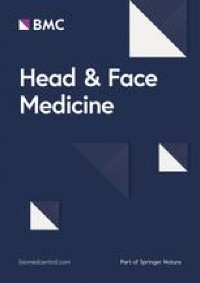|
Medicine RSS-Feeds by Alexandros G. Sfakianakis,Anapafseos 5 Agios Nikolaos 72100 Crete Greece,00302841026182,00306932607174,alsfakia@gmail.com
Πληροφορίες
Τρίτη 11 Μαΐου 2021
Auricular Perichondrium Graft for Septal Perforation Repair
Mapping the Risk Factors of Pharyngocutaneous Fistula After Salvage Laryngectomies
|
Can We Conquer Advanced Head and Neck Cancer? Current Status and Future Directions
|
The Choice of Anesthetic Agents for Endoscopic Sinus Surgery: Can Sinus Surgeons Be Involved?
|
Length of the Cricoid and Trachea in Children: Predicting Intubation Depth to Prevent Subglottic Stenosis
|
A Comparison of an Artificial Intelligence Tool to Fundamental Frequency as an Outcome Measure in People Seeking a More Feminine Voice
|
Intratympanic Steroid Injection Complicated by Iatrogenic Perilymphatic Fistula: A Cautionary Tale
|
Recognizing oneself in the encounter with others: Meaningful moments in systemic therapy for social anxiety disorder in the eyes of patients and their therapists after the end of therapy
|
COVID-19 and periodontitis: reflecting on a possible association
|
The diagnostic predictive value of neutrophil-to-lymphocyte ratio in thyroid cancer adjusted for tumor size
|
Presentation of External Ear Rosai-Dorfman Disease With Laryngeal Involvement
|
A Large Intratemporal Facial Nerve Schwannoma Presenting as an Occluding External Auditory Canal Mass
|
Αρχειοθήκη ιστολογίου
-
►
2023
(366)
- ► Φεβρουαρίου (184)
- ► Ιανουαρίου (182)
-
►
2022
(2814)
- ► Δεκεμβρίου (182)
- ► Σεπτεμβρίου (213)
- ► Φεβρουαρίου (264)
- ► Ιανουαρίου (262)
-
▼
2021
(3815)
- ► Δεκεμβρίου (229)
- ► Σεπτεμβρίου (276)
-
▼
Μαΐου
(423)
-
▼
Μαΐ 11
(25)
- Auricular Perichondrium Graft for Septal Perforati...
- Mapping the Risk Factors of Pharyngocutaneous Fist...
- Can We Conquer Advanced Head and Neck Cancer? Curr...
- The Choice of Anesthetic Agents for Endoscopic Sin...
- Length of the Cricoid and Trachea in Children: Pre...
- A Comparison of an Artificial Intelligence Tool to...
- Intratympanic Steroid Injection Complicated by Iat...
- Recognizing oneself in the encounter with others: ...
- COVID-19 and periodontitis: reflecting on a possib...
- The diagnostic predictive value of neutrophil-to-l...
- Presentation of External Ear Rosai-Dorfman Disease...
- A Large Intratemporal Facial Nerve Schwannoma Pres...
- Eine akute Fazialisparese als mögliche Impfkomplik...
- Endoscopic-Assisted Microsurgical Resection of Rig...
- Transinfratemporal Fossa Transposition of the Temp...
- The Efficacy of Adjuvant Chloroquine for Glioblast...
- Transcavernous Approach to the Anteromedial Triang...
- Transcavernous Resection of a Giant Extensive Chon...
- Transcavernous Approach for Microsurgical Clipping...
- Microsurgical resection of foramen magnum meningio...
- Skull base repair following endonasal pituitary an...
- The effect of prior radiation on the success of ve...
- Effects of nasal packing and transseptal suturing ...
- Chin Tuck Against Resistance Exercise for Dysphagi...
- Osseointegration of a novel 3D porous Ti-6Al-4V im...
-
▼
Μαΐ 11
(25)
- ► Φεβρουαρίου (64)
-
►
2020
(5754)
- ► Δεκεμβρίου (401)
- ► Σεπτεμβρίου (365)
- ► Φεβρουαρίου (754)
- ► Ιανουαρίου (894)
-
►
2019
(146)
- ► Δεκεμβρίου (19)
- ► Σεπτεμβρίου (54)





